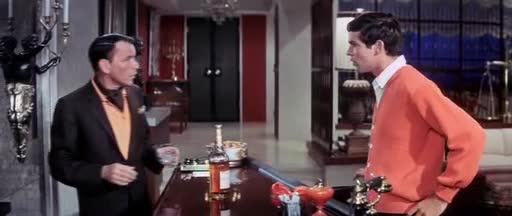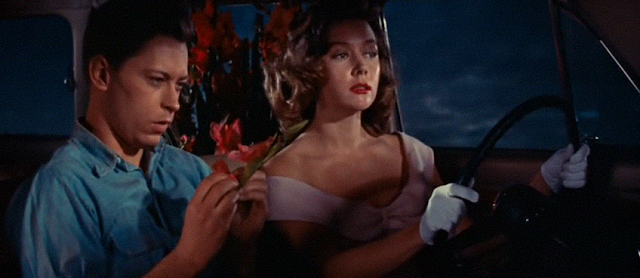 |
| A-M's kitten with a whip routine wreaks havoc with William Inge's kitchen sink drama, 'Bus Riley's Back in Town.' |
Bus Riley’s Back in Town
is one of those flicks that’s fondly remembered by some film fans but mostly forgotten
by mainstream movie audiences. The 1965 slice of life drama had a troubled
production, was not a critical or commercial success, isn’t often shown on
television, or readily available on DVD. I was thrilled when I finally found a good version of Bus Riley on line, and the link is at
the end of this essay.
 |
| Michael Parks had to live down "the next James Dean" label, in an era that was not looking for '50s rebels. |
I
am a movie buff with nostalgic memories of Bus
Riley’s Back in Town. The story of a sailor who comes back to his home
town, only to find out things have changed, and ultimately figures out he needs to change, as well, was a TV
staple in the ‘70s. Watching movies like Bus
Riley, Valley of the Dolls, and Peyton Place made me feel very grown up,
especially if I was watching with my Mom. She was a fan of Bus Riley’s Michael Parks, who had made a TV comeback with Then Came Bronson, the hippie biker with
the catch phrase, “Hang in there.”
Playwright
William Inge was to the Midwest what Tennessee Williams was to the South,
depicting lives of not-so-quiet desperation. Inge recycled some archetypes from
his most famous work, Picnic, to
portray small town life in Bus Riley’s
Back in Town: the sensible widow who takes in boarders; the insecure
"pretty" older and “sensitive” kid sisters; the neurotic old maid
school teacher; and the ne’er-do-well charmer who comes home and shakes things
up.
 |
| Ann-Margret is just a small town country club wife in 'Bus Riley's Back in Town!' |
There
are basically two movies going on in Bus.
One is a domestic comedy-drama, told realistically for the time, with a cast of
fine character actors who look and act like real people. Then there’s an Ann-Margret
melodrama, still in Kitten with a Whip
mode. After the opening scenes of the working class Riley family reunion with returning
sailor Bus, the film cuts to A-M’s Laurel, his sexy ex. She plays possum on her
pillow, when her rich older husband comes to her bed to say goodbye, before he
leaves on business. The film then turns into a Ross Hunter version of Cat on a Hot Tin Roof: A-M sulking in
bed, with a tidal wave of hair and ton of makeup, shot in gauzy cinematography
by Hunter's fave lensman, Russell Metty, all accompanied with swelling piano
music. And once Bus hits town, Ann-Margret’s local vixen turns into a crazy town
Maggie the Cat!
 |
| Ann-Margret is basically Maggie the Crazy Cat to Michael Parks' ambivalent Bus Riley. |
Most
of the film follows the small town dreams and disappointments of Bus Riley's family
and friends, which are often quite affecting. Then along comes A-M's Laurel,
who can't seem to decide whether she loves or hates Bus. Either way, A-M is
full-on Ann-Margrock, complete with babykins voice, sultry gazes through her
peek-a-boo hairdo, as she swans about in Jean Louis outfits. A-M’s character also
seems slightly insane, as she deliberately runs into Bus’ car as an excuse to
talk, stalks, bites, and even jumps into her pool fully dressed, all to seduce
him.
Most
absurd is when Laurel enlists her much older BFF "Benii" as her
“date,” in order to run into Bus at a local hot spot. A-M selects a slow sexy
number on the jukebox that sends her into a slithery, come hither routine, with
her aging pal dancing by himself, until she slinks her way back. Suddenly, it
feels like we’re in Twin Peaks! Lots
of A-M self-touching, with half-closed eyes, and full-hair tossing, that is totally
self-parody. This was one of several early Ann-Margret movies where her sex
symbol image was boosted at the expense of the film’s finished product. A-M was
also one of a number of starlets touted to be the next Marilyn Monroe, after MM’s
untimely demise.
 |
| Ann-Margaret's Laurel gets down with BFF "Benii" to vamp Bus. With color-coordinated their dancing shoes! |
Unfortunately,
the sex kitten with claws image was one that she had to live down. Finally, in
1970, directing great Mike Nichols did for A-M in Carnal Knowledge what he did for Elizabeth Taylor in Who's Afraid of Virginia Woolf? and
later, Cher, in Silkwood: shine a
light on the talent of a star with an over-exposed image. Ann-Margret went on
to become a terrific actress, especially in her later TV work.
The
break up between Laurel and Bus is Ann-Margret and Michael Parks’ best scene
together. A-M is at Laurel’s makeup table, perpetually putting on lipstick,
while Parks’ Bus is trying to have a serious talk with her. Bus takes the
lipstick and Laurel snatches it right back. When Parks slaps it out of her
hand, A-M snarls, “What?!!” Parks is most effective, soft-spoken as he explains
why he can’t be with her anymore, and Ann-Margaret shows a glimpse of her
future emotionalism as an actress, when Laurel realizes she’s really lost Bus
this time. It’s a startling scene.
 |
| Bus Riley and Laurel are about to break up again for good, in this intense scene that involves a flying lipstick! |
Prolific
television director Harvey Hart is quite capable with the cast, save
Ann-Margret. Michael Parks got a bad rap as a James Dean wannabe. While he did look like a more conventionally
good-looking version of Jimmy and occasionally affected the same method acting style
as Dean, he also has some Brando-esque moments as Bus Riley. In the film's
opening, he is awoken repeatedly, finally by his sister's noisy boyfriend,
making a racket in his car. His "Hey, Paula!" rant is a good-natured
homage to Marlon's famed "Hey, Stella!" There are other moments
when Parks gets to show his flair for dry humor. Yet, he also has a number of
subtle dramatic scenes, especially with Jocelyn Brando as his mother and Janet
Margolin, as a family friend he gradually realizes is a kindred spirit. All in all,
Michael Parks makes a good impression as Bus Riley, and it should have led to
better roles. I wonder if Michael Parks didn’t take off as a movie star because,
like Ann-Margret, getting groomed respectively as the next James Dean or
Marilyn Monroe by the mid-60s was passé.
 |
| The Riley family at breakfast, from left: Mimsy Farmer, Jocelyn Brando, and Kim Darby. And that's the back of Brett Somers' head, who plays their uptight boarder. |
Kim
Darby was quirky even as a teen and an acquired taste as a performer. Most
famous for True Grit, these qualities
suit her role as the offbeat kid sister, Gussie. The kid sis idolizes Bus, and
she and Parks have a sweet rapport. As her best friend Judy, Janet Margolin, of
the art house classic, David and Lisa,
is most appealing. As the girl stuck in the role of adult to her divorced,
depressed, and drinking mother, Margolin's doe-eyed looks and aching vulnerability
are a striking contrast to Ann-Margaret's tawdry antics.
 |
| Janet Margolin shines as Judy, the one who may be just the right girl for Bus Riley. |
Most
amusing is Brett Somers as the uptight boarder, Carlotta. Anybody who grew up
in the '70s remembers Brett as the game show version of Elaine Stritch on Match Game, sharing whiskey-voiced,
bawdy quips, and vying with Charles Nelson Reilly to see who could be more
outrageous. To see Somers clutching her pearls as Parks' Bus bumbles around in
his boxers or catches her on the can is especially hilarious.
Jocelyn
Brando plays the warm but pragmatic Mrs. Riley, and the scenes with her
children ring true. She brings a realistic mix of offering level-headed advice
for happiness in small town life, with a touch of resignation. Still, Brando,
who was Marlon's older sister, will always be Mommie Dearest's favorite reporter, Barbara Bennett from Redbook, to me!
 |
| Jocelyn Brando is great as always as Mrs. Riley, trying to keep wayward son Bus on the right track. |
Brad
Dexter, who seems to have been in every '60s movie, plays the Atomic vacuum
salesman who gives Bus a career break. Their scene with housewife Alice Pearce
(Bewitched's Gladys Kravitz #1) gives
the movie some intentional levity.
Another actress who has just one, but memorable scene, is Lisabeth Hush as Joy,
the Mrs. Robinson of Bus' little berg. She’s funny and sexy in her golden
lounging get-up, riffing and flirting on astrology and ESP, and offers this
classic come-on to salesman Bus: "Why be a square when the world is
round?"
 |
| Lisabeth Hush is a sly hoot as sexy housewife Joy, one of Bus' 'customers.' |
Ethel
Griffies, the ornithologist who offered dire warnings of The Birds, is a tough old bird of a matriarch from the local
funeral home here. Most striking is Crahan Denton as her closeted alcoholic mortician
son who offers Bus a job—with extra duties. With a hand on Bus' knee, there's a
striking close-up as he says, "I'm a lonely man, Bus." What's forward
thinking is at a funeral later, Bus holds no grudges and goes over to greet
him. In a similar vein, when Judy's alcoholic Mom dies in a fire caused by her
burning cigarette, there's a humane assessment of her disease, not demonization.
Even when Bus finally breaks up with Laurel, and she snaps that she hates him,
he just replies softly, "And I feel sorry for you." Considering the
hell she's put him through, I thought that was a most charitable answer.
 |
| Aside from the Dean comparisons, Michael Parks is sensitive, funny, and sexy as Bus Riley. |
Mimsy
Farmer—love that name!—as the older, pretty sister Paula, is alternately snarky
and sweet; Larry Storch is the likeable barkeep pal; Nan Martin’s a believable
mess as Judy's mother; and David Carradine, creepy even then, is Bus' buddy
Stretch. Star Trek’s Scotty himself,
James Doohan, rounds out the stellar cast.
 |
| David Carradine makes an early film appearance as an old high school pal of Parks' Bus Riley. |
Much
was made when William Inge requested that his name be removed from Bus Riley’s Back in Town credits, due to
changes made by the film’s producer, Elliot Kastner, to "glorify
Ann-Margret." The screenplay was credited to "Walter Gage" in
the finished film. A decade later, Ann-Margret told her side, saying the
changes were made to soften her character, and that she wasn’t happy about it,
either.
Could
those cut scenes be restored and the re-shoots removed? Hard to say, but my
guess is highly unlikely. At least it would make great fodder for a Bus Riley DVD. Meanwhile, you can either
savor the small town fare of Bus Riley
or chuckle at the deep dish camp of Ann-Margret purring and sneering her way
through this bi-polar bonanza.
Watch
Bus Riley’s Back in Town here: https://rarefilmm.com/2018/07/bus-rileys-back-in-town-1965/
 |
| Ann-Margret plays with her... oh, never mind! |



















